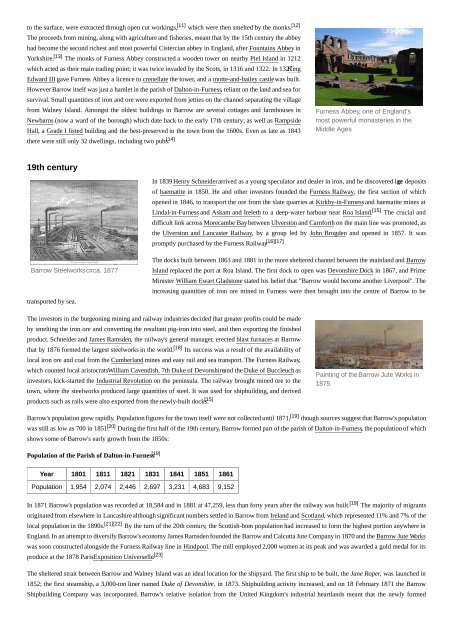pdf-zusammengefasst
Create successful ePaper yourself
Turn your PDF publications into a flip-book with our unique Google optimized e-Paper software.
to the surface, were extracted through open cut workings, [11] which were then smelted by the monks. [12]<br />
The proceeds from mining, along with agriculture and fisheries, meant that by the 15th century the abbey<br />
had become the second richest and most powerful Cistercian abbey in England, after Fountains Abbey in<br />
Yorkshire. [13] The monks of Furness Abbey constructed a wooden tower on nearby Piel Island in 1212<br />
which acted as their main trading point; it was twice invaded by the Scots, in 1316 and 1322. In 1327 King<br />
Edward III gave Furness Abbey a licence to crenellate the tower, and a motte-and-bailey castle was built.<br />
However Barrow itself was just a hamlet in the parish of Dalton-in-Furness, reliant on the land and sea for<br />
survival. Small quantities of iron and ore were exported from jetties on the channel separating the village<br />
from Walney Island. Amongst the oldest buildings in Barrow are several cottages and farmhouses in<br />
Newbarns (now a ward of the borough) which date back to the early 17th century; as well as Rampside<br />
Hall, a Grade I listed building and the best-preserved in the town from the 1600s. Even as late as 1843<br />
there were still only 32 dwellings, including two pubs. [14]<br />
Furness Abbey, one of England's<br />
most powerful monasteries in the<br />
Middle Ages<br />
19th century<br />
In 1839 Henry Schneider arrived as a young speculator and dealer in iron, and he discovered lar ge deposits<br />
of haematite in 1850. He and other investors founded the Furness Railway, the first section of which<br />
opened in 1846, to transport the ore from the slate quarries at Kirkby-in-Furness and haematite mines at<br />
Lindal-in-Furness and Askam and Ireleth to a deep-water harbour near Roa Island. [15] The crucial and<br />
difficult link across Morecambe Bay between Ulverston and Carnforth on the main line was promoted, as<br />
the Ulverston and Lancaster Railway, by a group led by John Brogden and opened in 1857. It was<br />
promptly purchased by the Furness Railway. [16][17]<br />
Barrow Steelworks circa. 1877<br />
transported by sea.<br />
The docks built between 1863 and 1881 in the more sheltered channel between the mainland and Barrow<br />
Island replaced the port at Roa Island. The first dock to open was Devonshire Dock in 1867, and Prime<br />
Minister William Ewart Gladstone stated his belief that "Barrow would become another Liverpool". The<br />
increasing quantities of iron ore mined in Furness were then brought into the centre of Barrow to be<br />
The investors in the burgeoning mining and railway industries decided that greater profits could be made<br />
by smelting the iron ore and converting the resultant pig-iron into steel, and then exporting the finished<br />
product. Schneider and James Ramsden, the railway's general manager, erected blast furnaces at Barrow<br />
that by 1876 formed the largest steelworks in the world. [18] Its success was a result of the availability of<br />
local iron ore and coal from the Cumberland mines and easy rail and sea transport. The Furness Railway,<br />
which counted local aristocrats William Cavendish, 7th Duke of Devonshireand the Duke of Buccleuch as<br />
investors, kick-started the Industrial Revolution on the peninsula. The railway brought mined ore to the<br />
town, where the steelworks produced large quantities of steel. It was used for shipbuilding, and derived<br />
products such as rails were also exported from the newly-built docks. [15]<br />
Painting of the Barrow Jute Works in<br />
1875<br />
Barrow's population grew rapidly. Population figures for the town itself were not collected until 1871, [19] though sources suggest that Barrow's population<br />
was still as low as 700 in 1851. [20] During the first half of the 19th century, Barrow formed part of the parish of Dalton-in-Furness, the population of which<br />
shows some of Barrow's early growth from the 1850s:<br />
Population of the Parish of Dalton-in-Furness [19]<br />
Year 1801 1811 1821 1831 1841 1851 1861<br />
Population 1,954 2,074 2,446 2,697 3,231 4,683 9,152<br />
In 1871 Barrow's population was recorded at 18,584 and in 1881 at 47,259, less than forty years after the railway was built. [19] The majority of migrants<br />
originated from elsewhere in Lancashire although significant numbers settled in Barrow from Ireland and Scotland, which represented 11% and 7% of the<br />
local population in the 1890s. [21][22] By the turn of the 20th century, the Scottish-born population had increased to form the highest portion anywhere in<br />
England. In an attempt to diversify Barrow's economy James Ramsden founded the Barrow and Calcutta Jute Company in 1870 and the Barrow Jute Works<br />
was soon constructed alongside the Furness Railway line in Hindpool. The mill employed 2,000 women at its peak and was awarded a gold medal for its<br />
produce at the 1878 Paris Exposition Universelle. [23]<br />
The sheltered strait between Barrow and Walney Island was an ideal location for the shipyard. The first ship to be built, the Jane Roper, was launched in<br />
1852; the first steamship, a 3,000-ton liner named Duke of Devonshire, in 1873. Shipbuilding activity increased, and on 18 February 1871 the Barrow<br />
Shipbuilding Company was incorporated. Barrow's relative isolation from the United Kingdom's industrial heartlands meant that the newly formed


















